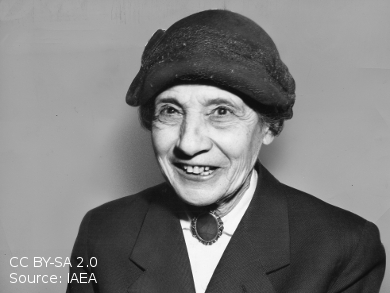Lise Meitner was born on November 7, 1878, in Vienna, Austria. At the time, female students were not allowed to attend schools that prepared them for university, so she had to take the relevant examination as an external, self-taught candidate. She passed and, in 1901, she started her studies of physics, mathematics, and philosophy at the University of Vienna. One of her teachers there was Ludwig Boltzmann. In 1906, she received her Ph.D. in physics, only the second women to do so at the University of Vienna.
In 1907, Meitner moved to Berlin, Germany, to continue her studies and attend lectures by Max Planck. In Berlin, she met Otto Hahn, with whom she would collaborate for decades. In 1912, both of them moved to the newly founded Kaiser Wilhelm Institute for Chemistry in Berlin-Dahlem. During World War I, Meitner trained to be a radiographer and nurse and served in an Austrian military hospital. She returned to Berlin-Dahlem in 1916.
In 1917, Meitner and Hahn discovered the isotope protactinium-231 [1]. In 1918, Meitner, who had previously worked as an unpaid guest researcher, was given her own section at the Kaiser Wilhelm Institute for Chemistry. In 1926, she joined the University of Berlin as the first female Professor of Physics in Germany. Due to her Jewish heritage, she lost this post in 1933 when the national socialist regime came into power. She was able to continue her work at the private Kaiser Wilhelm Institute, but in 1938, she had to leave Germany and fled to Sweden via The Netherlands. Otto Hahn supported her and gave her a diamond ring he had inherited, to be used as a possible bribe at the border.
Meitner and Hahn continued to collaborate at a distance. Hahn and colleagues continued their research at the Kaiser Wilhelm Institute. The team bombarded uranium with neutrons, trying to synthesize new elements. In late 1938, they found barium in the products, a lighter element, which they could not explain at first. This turned out to be the effect of nuclear fission, which had never been observed before.
Meitner worked together with her nephew Otto Robert Frisch on the theoretical interpretation of these experiments [2]. Hahn was awarded the Nobel Prize in Chemistry in 1944 “for his discovery of the fission of heavy nuclei”. That neither Meitner, Frisch, nor Hahn’s younger colleagues shared this prize has been considered controversial. Meitner had been nominated a total of 48 times, both for the Nobel Prize in Physics and the Nobel Prize in Chemistry.
In Stockholm, Sweden, Meitner continued to work on nuclear physics. She was a proponent of the peaceful use of nuclear fission and opposed the development and use of nuclear weapons. Meitner retired to Cambridge, UK, in 1960, where her nephew Otto Robert Frisch lived at the time, and died there on October 27, 1968.
Lise Meitner is the answer to Guess the Chemist (82).
References
[1] Die Muttersubstanz des Actiniums, Ein Neues Radioaktives Element von Langer Lebensdauer (in German),
Lise Meitner,
Z. Elektrochem. Angew. Phys. Chem. 1918, 24, 169–173.
https://doi.org/10.1002/bbpc.19180241107
[2] Disintegration of Uranium by Neutrons: a New Type of Nuclear Reaction,
Lise Meitner, O. R. Frisch,
Nature 1939, 143, 239–240.
https://doi.org/10.1038/143239a0
Sources
- Lise Meitner, 1878–1968,
Otto Robert Frisch,
Biogr. Mem. Fellows Royal Soc. 1970, 16, 405–420.
https://doi.org/10.1098/rsbm.1970.0016 - A Nobel Tale of Postwar Injustice,
Elisabeth Crawford, Ruth Lewin Sime, Mark Walker,
Phys. Today 1997, 50, 26–32.
https://doi.org/10.1063/1.881933 - Lise Meitner und die Kernspaltung (in German),
Ruth Lewin Sime,
Spektrum der Wissenschaft 1998, 5, 80.
Selected Publications
- Über die Absorption der α- und β-Strahlen (in German),
Lise Meitner,
Phys. Z. 1906, 7, 588–590. - Über das Protactinium und die Frage nach der Möglichkeit seiner Herstellung als chemisches Element (in German),
Otto Hahn, Lise Meitner,
Naturwissenschaften 1919, 7, 611–612.
https://doi.org/10.1007/bf01498184 - Über den Aufbau des Atominnern (in German),
Lise Meitner,
Naturwissenschaften 1927, 15, 369–378.
https://doi.org/10.1007/bf01504760
Also of Interest
- 50th Anniversary: Death of Otto Hahn,
ChemistryViews 2018.
Chemistry Nobel Laureate for the discovery of nuclear fission - Video: Great Architecture and Chemists in Dahlem,
Chemistryviews.org 2018.



